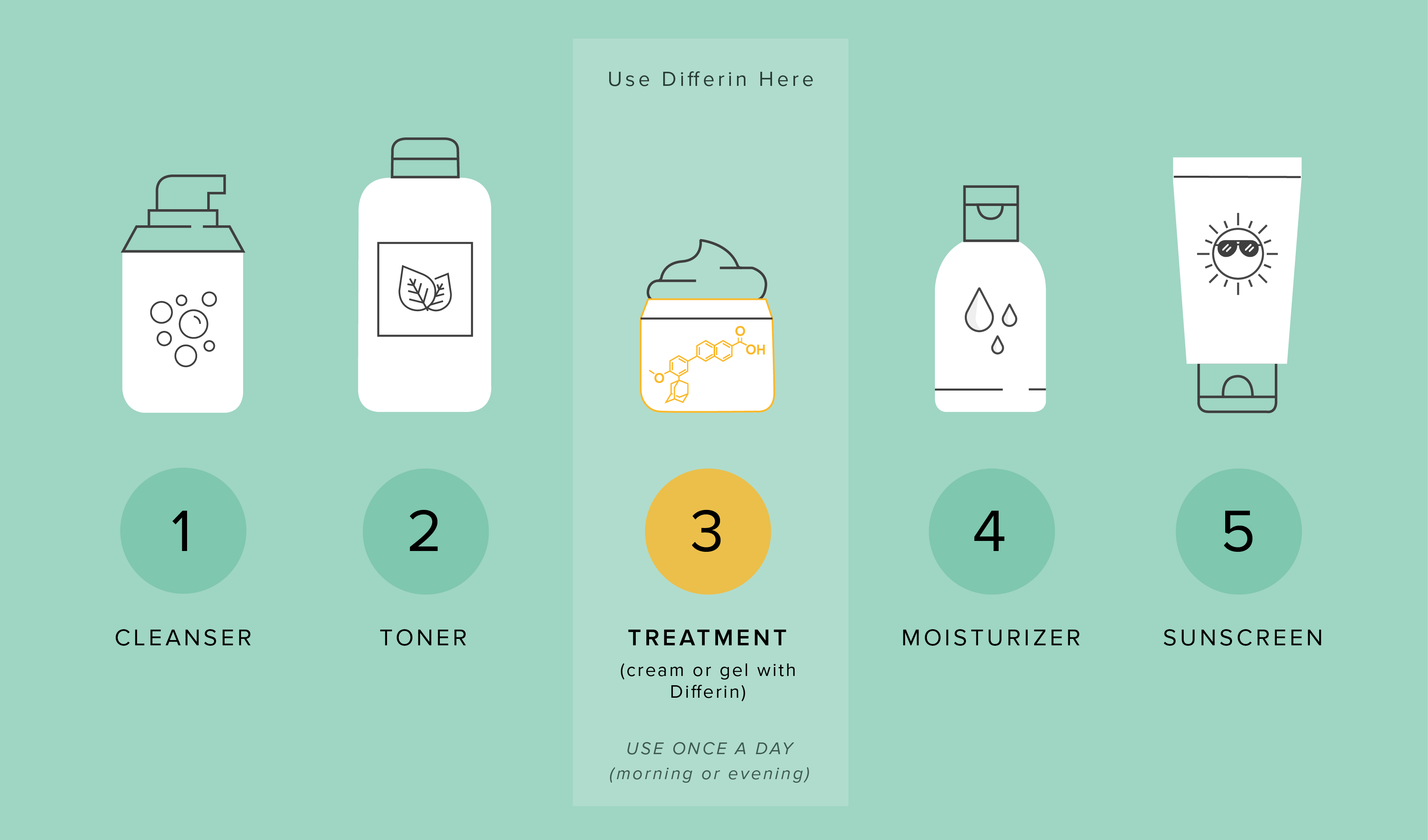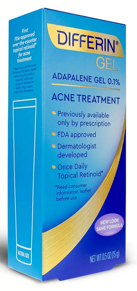Adapalene Skin Care Benefits:
All You Need to Know
Adapalene is a dermatologist-created retinoid that is used for the topical treatment of acne and is best known as the active ingredient in the brand name product, Differin (think of adapalene as the active ingredient in Differin like ibuprofen is the active ingredient in Advil). Adapalene was created by dermatologists to be an alternative to Retin-A for those with sensitive skin: it's a strong acne fighter without the harsh skin irritation often caused by Retin-A. Adapalene fights existing acne by unclogging blocked pores. Additionally, adapalene's anti-inflammatory properties calm redness and swelling from acne. Adapalene is also a comedolytic meaning it prevents future whiteheads and blackheads from forming.
Fun Fact: Adapalene is the only FDA-approved retinoid available over the counter to clear acne - it was approved in 2016 by the FDA and is the newest advancement in over the counter acne treatment in over 30 years.
Adapalene
INGREDIENT CATEGORY: Retinoid
BEST FOR TREATING: Acne & Blemishes
SKIN TYPES FOR USE: All
SAFETY: Adapalene is safe for topical use in concentrations of up to 0.3% in skin care products
GHS TIP: It can take up to 6 weeks of consistent topical use of adapalene (or Differin) before you begin to see improvements
Top 4 Adapalene Skin Care Benefits
✓ Unclogs Pores
FIGHTS ACNE FROM WITHIN
All types of acne (whiteheads, blackheads, cystic acne, etc.) start with the formation of a microcomedone or a blocked pore. As to how microcomedones form, it's important to understand the natural process of skin cell renewal. Skin cells are created in deeper layers of skin, rise up to the surface, die, and in healthy skin, shed off of the skin's surface on their own. Since your skin is constantly renewing itself, new cells are being created, dying, and sloughing off continuously. Even though this process is constant, some skin cells can have trouble breaking away when they reach the skin's surface. This presents a problem because all the skin cells underneath them (that are trying to rise up and shed away themselves) get blocked. With nowhere to go, dead skin cells can build up within the pore and eventually block the pore completely. When dead skin covers the top of a pore, oil gets trapped, acne bacteria starts thriving, and voila! Acne forms. Adapalene, the active ingredient in Differin, fights acne by preventing pores from getting clogged with dead skin in the first place. How? In a review of the use of adapalene for the treatment of acne, adapalene was shown to prevent blocked pores by getting dead skin cells to shed/break away once they reach the skin's surface. Adapalene does this by normalizing the skin cell creation process. As your skin creates brand new skin cells, adapalene ensures the new cells are pre-programmed to shed when they reach the surface of your skin (vs. stay binded to one another and cover the pore). This prevents dead skin cells from building up and blocking your pores.
✓ Prevents Future Acne
KEEPS PORES CLEAN
Adapalene is a comedolytic meaning it prevents future acne from developing. By keeping pores unclogged, no whiteheads and blackheads form from trapped excess oil or dead skin cells hanging around. Because it prevents whiteheads and blackheads from coming back, adapalene is an excellent ingredient to incorporate into your maintenance regimen if you have acne-prone skin.
Other comedolytics include salicylic acid, benzoyl peroxide, and azelaic acid
✓ Powerful Anti-Inflammatory
REDUCES REDNESS
Adapalene is an anti-inflammatory that reduces redness and swelling associated with acne. According to studies on the anti-inflammatory properties of topical retinoids, adapalene is especially effective against inflamed acne (like papules and pustules).
✓ Less Irritating than Retin-A
GREAT FOR SENSITIVE SKIN
Studies have found that adapalene produces results faster than retin-A and is less irritable than retin-A, making it a great option for babes with sensitive skin.
When to Use Adapalene
SKIN CARE ROUTINE OPTION:
A cream or gel with adapalene - use once a day (morning or evening)

How to Apply Adapalene
Work up to it
Always patch test before applying to your entire face! Apply Differin or any other adapalene product in the evening to a small area on your forehead (where your facial skin is thickest). Wait about 4 days before reapplying to see how your skin will react. It takes 3-4 days for the side effects from the first application of an adapalene product to become apparent. If there is no irritation after 4 days, apply a thin layer of Differin or another adapalene product to your entire face once a day (either morning or evening).

Apply to entire face
Adapalene works best when applied to your entire face (avoid eyes, lips, and mouth) because it fights acne at the source by working at a cellular level to unclog your pores. It's great because it clears acne and helps prevent future breakouts.

Less is more
Applying more of Differin or any other adapalene product will not make it work faster. In fact, over applying Differin will damage your skin’s protective barrier causing dried out skin as well as giving bacteria and other impurities the opportunity to more easily get inside your skin and cause future breakouts.

Follow Up With...
Use a moisturizer twice a day to balance out the drying effects from your Differin product.
All adapalene products, including Differin, makes your skin EXTRA sensitive to UV rays. Limit your time in the sun and apply sunscreen daily.
Adapalene in Products


Acne & Blemishes


All Skin Types!


Creams/Gels


Over the Counter
Prescribed Medication
Top 3 Adapalene Skin Care Products
We’ve put together a GHS curated selection of our favorite skin care products that contain adapalene for fighting acne and breakouts. All the products we’ve chosen are sulfate-free and phthalate-free. Remember - results won’t happen overnight. It can take up to 6 weeks of consistent topical use before you begin to see improvements, so stay consistent with your product usage.
One thing to note: we do not like promoting products with parabens, but unfortunately, all the topical products currently available to consumers on the market that contain adapalene (Differin) also contain methylparaben. If you want paraben-free acne products, check out salicylic acid, benzoyl peroxide, and azelaic acid.
Use in PM
Apply this gel once a day to your face post cleansing, exfoliating, and toning.
Price $
Certified: sulfate-free, phthalate-free
Use in PM
Apply this gel once a day to your face post cleansing, exfoliating, and toning.
Price $$
Certified: sulfate-free, phthalate-free
Use in PM
Apply this gel once a day to your face post cleansing, exfoliating, and toning.
Price $$
Certified: sulfate-free, phthalate-free
GHS Tips
Consistency is key
Results won’t happen overnight. Although adapalene works faster than other retinoids, it can still take up to 6 weeks of consistent topical use before you begin to see improvements. Be patient - if you don’t see improvement after 90 days, then we recommend trying another adapalene product or another acne fighting ingredient like salicylic acid, benzoyl peroxide, or azelaic acid

Close the cap with use
All adapalene products, including Differin, oxidize with too much air contact (meaning they won’t work anymore). Remember to always put the cap on after each use. If you forget to close the cap and your adapalene product is exposed to air for an extended period of time, the acne fighting capabilities of adapalene will be ruined.

Safety Tips
Adapalene is FDA Approved and safe for topical use containing adapalene in concentrations of up to 0.3% in skin care products.
SIDE EFFECTS OF ADAPALENE SKIN PRODUCTS:
- redness or irritation
- dryness, itching, or peeling
- purging (worsening of acne) within the first few weeks
- post-inflammatory hyperpigmentation
✓ Wear sunscreen!
✓ Close the cap with use
✓ Consider consulting a dermatologist - let them determine the right adapalene (differin) concentration for you
X Don't use Differin or any other adapalene products with AHAs, benzoyl peroxide, or salicylic acid - combining these can lead to additional redness, dryness, and irritation
FAQs about Adapalene (Differin)
Q. What is Differin?
Differin is a brand name product that contains the active ingredient adapalene (think of adapalene as the active ingredient in Differin like ibuprofen is the active ingredient in Advil). Differin is FDA approved for the topical treatment of acne and was developed by dermatologists to be a less irritating, over-the-counter alternative to Retin-A. A strong acne fighter, Differin clears existing acne by unclogging blocked pores, all without the harsh skin irritation often caused by Retin-A. Additionally, Differin's anti-inflammatory properties calm redness and swelling from acne. Adapalene, Differin's active ingredient, is also a comedolytic meaning it prevents future whiteheads and blackheads from forming.
 Q. What makes adapalene different from benzoyl peroxide or salicylic acid?
Q. What makes adapalene different from benzoyl peroxide or salicylic acid?Adapalene, benzoyl peroxide, and salicylic acid are all acne fighting ingredients, but they differ in how they fight acne. All three ingredients clear existing acne by unclogging zits/pores, and all three prevent future acne by maintaining clean pores; however, the key difference is benzoyl peroxide and salicylic acid attack acne by penetrating the surface of the skin, while adapalene fights acne from the inside out. Out of these three ingredients, benzoyl peroxide is the best at fighting acne bacteria (but if you have cystic acne, we recommend using a product with azelaic acid instead), and salicylic acid is the best ingredient for oil control. On the other hand, adapalene (the active ingredient in the product Differin) is the newest advancement in acne treatment available without a prescription in over 30 years, and adapalene works at the DNA level to pre-program skin cells to exfoliate (vs. stay attached to your skin after they die and clog your pores). From a sensitivity perspective, Adapalene was formulated specifically with skin sensitivity in mind (to be a less harsh version of Retin-A). Although powerful, benzoyl peroxide can be irritating to sensitive skin. All three skin care ingredients have anti-inflammatory properties, but adapalene is the strongest against acne inflammation.
At the end of the day, adapalene, benzoyl peroxide, and salicylic acid are all great acne fighting ingredients. If you are just getting started with acne ingredients, try a salicylic acid product. If you end up needing something stronger, then think about trying an adapalene or benzoyl peroxide product. The main thing is do not use adapalene at the same time as benzoyl peroxide or salicylic acid (this combo will be too harsh on your skin).
 Q. What is adapalene used for in skin care?
Q. What is adapalene used for in skin care?Adapalene is used to treat the following skin concerns:
- Acne & Blemishes
 Q. How does adapalene benefit my skin?
Q. How does adapalene benefit my skin?The top 4 adapalene skin benefits are:
- Unclogs pores and fights acne from within
- Prevents future acne by keeping pores clean
- Powerful anti-inflammatory that reduces redness and swelling
- Less irritating than Retin-A
 Q. What skin types is adapalene good for?
Q. What skin types is adapalene good for?Adapalene is safe to use on all skin types.
 Q. Is adapalene safe for my skin?
Q. Is adapalene safe for my skin?Adapalene is safe for topical use in concentrations of up to 0.3% in skin care products.
 Q. What are common side effects from applying adapalene topically?
Q. What are common side effects from applying adapalene topically?Redness or irritation, dryness, itching, peeling, purging (worsening of acne) within the first few weeks, or post-inflammatory hyperpigmentation can be common side effects from applying adapalene topically. Note that any side effects from adapalene shouldn't be as harsh as side effects commonly experienced with Retin-A. Always be sure to do a patch test on a thicker part of your skin (square inch on your arm or forehead) before applying a new product to your entire face.
 Q. How long does adapalene take to work topically?
Q. How long does adapalene take to work topically?Results will not happen overnight. It can take up to 6 weeks of consistent topical application of adapalene before you begin to see improvements. Remember - consistency is key for optimal results.
 Q. Can I mix adapalene with alpha hydroxy acids (AHAs), benzoyl peroxide or salicylic acid?
Q. Can I mix adapalene with alpha hydroxy acids (AHAs), benzoyl peroxide or salicylic acid?Do not use adapalene at the same time as products containing alpha hydroxy acids (i.e. glycolic acid or lactic acid), benzoyl peroxide, or salicylic acid. This combo can be extra irritating, so you'll have to make a choice. Be nice to your skin.
 Q. Can adapalene remove acne scars?
Q. Can adapalene remove acne scars?No, adapalene does not treat hyperpigmentation, so it will not effectively remove acne scars. If you are trying to lighten acne scars, look into these ingredients:
If you have cystic acne and you want to lighten acne scars simultaneously, check out azelaic acid.
 Q. Does adapalene cause purging?
Q. Does adapalene cause purging?Yes, adapalene can cause acne purging, but don't worry--this is actually a good thing. Long story short, purging means your adapalene product is actually working. If you already have existing microcomedones (blocked pores that are the precursor to all forms of acne), adapalene is going to make those microcomedones turn into ance and blemishes faster (as in, you would have gotten them anyways). Think of it like taking all the brewing zits, and making them all come to life at once so that you can wipe them all out at the same time. After the purge, your skin should clear up as long as you continue to apply daily. And what are you left with? A pure, clean slate. However, if the product is causing you to break out in places you don’t normally break out, or your acne has become inflamed, then this is a negative reaction. In this case, you should discontinue using the product because it’s irritating your skin.
 Q. How long does the “purge” time period last?
Q. How long does the “purge” time period last?Purging should only last up to a month. If your skin isn’t getting better after 6-8 weeks of using the adapalene product, ditch it.
 Q. Can adapalene be used for wrinkles and anti-aging?
Q. Can adapalene be used for wrinkles and anti-aging?Adapalene is not FDA approved for lessening the appearance of fine lines and wrinkles. If you are looking for an ingredient that is proven to both fight acne and reduce fine lines and wrinkles, you can consider tretinoin (the active ingredient in Retin-A). Just know that tretinoin is stronger and more irritating than adapalene. If you can also use an adapalene product to fight acne and another product to target anti-aging. Try a vitamin C or vitamin E product (both of these are safe to use at the same time as adapalene).
 Q. Will adapalene bleach my clothes?
Q. Will adapalene bleach my clothes?No, adapalene does not stain or bleach fabric like benzoyl peroxide.
 Q. Do adapalene skin care products expire?
Q. Do adapalene skin care products expire?Yes. Look for either an expiration date or a POA (prescribed period after opening). A POA tells you how long the product is good for after opening. If your adapalene product has expired, do not use it - expired products can cause skin irritation, bacterial infection, or breakouts.
 Q. What are common names used to identify adapalene on an ingredient list for skin care products?
Q. What are common names used to identify adapalene on an ingredient list for skin care products?- Adapalene
 Q. What professinal skin care brand products contain adapalene?
Q. What professinal skin care brand products contain adapalene?Differin is the most common brand name product that contains adapalene.

Want More GHS Tips?
It’ll be the best thing to ever slide into your DM's.


